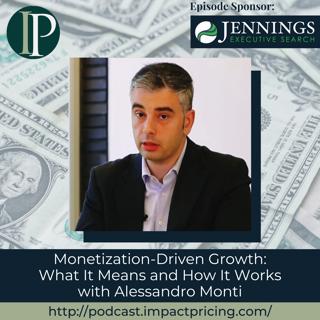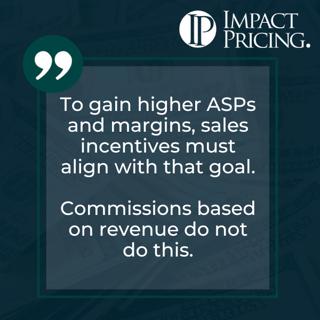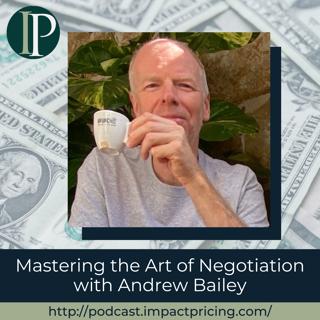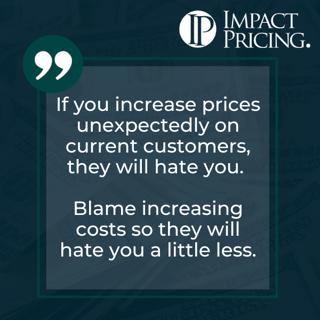
Blogcast: Price Segmentation by Negotiating
This is an Impact Pricing Blog published on May 4, 2023, turned into an audio podcast so you can listen on the go. Read Full Article Here: https://impactpricing.com/blog/price-segmentation-by-negotiating/ If you have any feedback, definitely send it. You can reach us at mark@impactpricing.com. Now, go make an impact. Connect with Mark Stiving: Email: mark@impactpricing.com LinkedIn: https://www.linkedin.com/in/stiving/
9 Kesä 20232min

Pricing Table Topics: 5 of Diamonds – Give Salespeople Discount Authority
This one is the 5 of Diamonds from the Selling Value card deck. We typically give our salespeople some level of discount authority. And the reason we do that is, let's say they walked in, and they asked the factory, or headquarters, 'Hey, could I have a 5% discount?' And we always say yes to that. Then all we've done is slowed down the sales process. Instead, we give them some level of discount authority. Knowing that, you know, if you come in for 5% or less, I'm going to give it to you anyway. So, you just have permission to go give 5% or less. The problem, of course, is that salespeople typically give the max that they're allowed to give. There's all these different levers that they could pull. They could sell value, and they can discount price. And discounting price is one of those levers that they're going to pull because it's easy. See how easy it is for me to discount the 5% and it doesn't hit my commission that much. So, it's okay for me to give that 5% discount. What we want to do as a company is sit back and say, what are the right levels of discount authority? What should I let my salesperson discount to? What should I let my sales managers discount to, my sales directors discount to? There are different levels, and we want them to be incented to discount as little as possible. We hope you enjoyed this example of Pricing Table Topics. What you just heard was done without a script. If you want to get better at speaking about pricing and value, grab a deck of our cards, pick a card, read the saying, then talk for one to two minutes about what that card says. You'll become a better speaker and expert. If you have any questions or feedback, please email me, mark@impactpricing.com. Now, go make an impact. Connect with Mark Stiving: Email: mark@impactpricing.com LinkedIn: https://www.linkedin.com/in/stiving/
7 Kesä 20232min

Monetization-Driven Growth: What It Means and How It Works with Alessandro Monti
Alessandro Monti is a pricing enthusiast and expert on all topics related to monetization, conversion, upselling, digital pricing, price management, and business and pricing history. In this episode, Alessandro highlights the importance of adopting a monetization-led growth approach for your business and emphasizes the need to start implementing this strategy early on in your business. Why you have to check out today's podcast: Learn to redefine growth in the sense of making it profitable and sustainable Discover the importance of a monetization-driven growth strategy for the long-term success and sustainability of your business Find the ideal pricing metric for your business to attain optimal product-pricing-market fit and achieve success "Choosing the appropriate price metric seems to be probably one of these game-changing moments for your businesses." - Alessandro Monti Topics Covered: 01:32 - What brought him to pricing and what made him choose SKP 02:43 - Why he believes in supply and demand 06:01 - Delving into the concept of "growth at any cost" and shifting our focus away from it 08:31 - Defining digital industry and turning away from this 'growth at any cost' mentality 09:36 - Redefining growth 12:25 - Challenging the tools and techniques to get to this ultimate growth 14:49 - Deciding between freemium and free trial [and starting monetization-led growth early on in the business] 20:25 - Extracting value to monetize a product and what is true business success 23:03 - Alessandro's best pricing advice that impacts anyone's business 24:05 - Finding the best pricing metric to use Key Takeaways: "Let's redefine growth in the sense of let's make profitable business." - Alessandro Monti "We don't need the free, just for the sake of having free because there is value in having free users. But besides that, I think you need to seek the conversion and the monetization as early as possible." - Alessandro Monti "It's growth understood as profitability using all of our modern monetization techniques and there's room for alternative content." - Alessandro Monti People / Resources Mentioned: Taylor Swift: https://www.taylorswift.com/ Connect with Alessandro Monti: LinkedIn: https://www.linkedin.com/in/profmonti/ Connect with Mark Stiving: LinkedIn: https://www.linkedin.com/in/stiving/ Email: mark@impactpricing.com
5 Kesä 202327min

Blogcast: Simplify Your Pricing
This is an Impact Pricing Blog published on April 27, 2023, turned into an audio podcast so you can listen on the go. Read Full Article Here: https://impactpricing.com/blog/simplify-your-pricing/ If you have any feedback, definitely send it. You can reach us at mark@impactpricing.com. Now, go make an impact. Connect with Mark Stiving: Email: mark@impactpricing.com LinkedIn: https://www.linkedin.com/in/stiving/
2 Kesä 20233min

Pricing Table Topics: 5 of Clubs – Gain Higher ASPs and Margins
This one is the 5 of Clubs from the Selling Value card deck. Most salespeople are paid on commission, and typically that commission is a percentage of the revenue. So, 2% of the revenue, 5% of the revenue, somewhere in that ballpark. The problem is, that incremental revenue, if I want to grow my revenue by 1%, the salesperson is only going to get 2%, or their commission rate, of the 1%. And it's a really, really tiny number. However, for the company, that 1% could be a really big number especially if your overall margins are relatively small, because that incremental 1% of revenue is a hundred percent profit. But we don't incentivize our salespeople to get that next 1% very much. Ideally, what we would do is, we would create a sales incentive structure so that covering costs, maybe they don't make anything, but anything from cost to list price, the amount of commission, the amount of incentive payment they get goes up for the higher the price they get. I, typically, like to have a target price. I also have a list price and a floor price. And I'll set three different commission rates. Anybody who can sell at list gets a really high commission rate. Anybody who sells at Target or above gets a mid-level commission rate. Anybody who sells above the floor and below the target, it's a really low commission rate. But the key is, we want to give our salespeople incentives to negotiate for that last 1%. We hope you enjoyed this example of Pricing Table Topics. What you just heard was done without a script. If you want to get better at speaking about pricing and value, grab a deck of our cards, pick a card, read the saying, and talk for one to two minutes about what that card says. You'll become a better speaker and expert. If you have any questions or feedback, please email me, mark@impactpricing.com. Now, go make an impact. Connect with Mark Stiving: Email: mark@impactpricing.com LinkedIn: https://www.linkedin.com/in/stiving/
31 Touko 20232min

Mastering the Art of Negotiation with Andrew Bailey
Andrew Bailey is a Value Pricing and Price Negotiation Specialist. He is the founder of Commercial Strategy 4. He helps you unleash your pricing power to sell more, more often, and at a higher price to achieve the profits you deserve. In this episode, Andrew shares his strategy for value-based pricing negotiations to help you achieve the highest possible pricing for your product or service. Why you have to check out today's podcast: Explore how you can present alternative options during negotiations by combining price and value selling strategies Discover one great technique for setting the stage and preparing the buyer's mindset for a pricing value conversation Uncover a more effective approach to pricing instead of simply relying on discounts "Improve your prices and just get really good at customer conversations." - Andrew Bailey Topics Covered: 01:14 - How he started in pricing 03:40 - Important consideration for negotiation 04:58 - Defining value for clients and questions to ask to understand the value you're delivering 09:21 - Dealing with procurement people versus the pricing committee as you go through value discovery process 12:32 - Key insights on opposing viewpoints between procurement and committee 14:28 - Practicing real-life price negotiations 16:36 - Pricing and value negotiation strategy that people rarely do but should be considered 24:08 - The biggest mistake in pricing negotiations and what should be done instead 27:53 - Andrew's best pricing advice to impact one's business Key Takeaways: "Ultimately, your ability to achieve the results that you want in pricing and negotiating is focused around your negotiating strength." - Andrew Bailey "What I talk to people about is understanding what's really important to customers, what matters to them." - Andrew Bailey "Don't try to make a whole long list of things that you can do for your clients and customers. It's probably two or three things that's really important to them. Just focus on that. That's a great place to get to." - Andrew Bailey "We can give some discount and then we agree to it without really thinking about, could we do this differently? Is there a better way, is there more value here than simply that price and that quantity?" - Andrew Bailey Connect with Andrew Bailey: LinkedIn: https://www.linkedin.com/in/pricingmentor/?originalSubdomain=uk Email: andrew@pricewithoutfear.com Connect with Mark Stiving: Email: mark@impactpricing.com LinkedIn: https://www.linkedin.com/in/stiving/
29 Touko 202330min

Blogcast: Nobody Cares About Your Product
This is an Impact Pricing Blog published on April 20, 2023, turned into an audio podcast so you can listen on the go. Read Full Article Here: https://impactpricing.com/blog/nobody-cares-about-your-product/ If you have any feedback, definitely send it. You can reach us at mark@impactpricing.com. Now, go make an impact. Connect with Mark Stiving: Email: mark@impactpricing.com LinkedIn: https://www.linkedin.com/in/stiving/
26 Touko 20234min

Pricing Table Topics: 5 of Hearts – Blame Costs When You Increase Prices
This one is the 5 of Hearts from the Selling Value card deck. It's true, customers hate price increases. Heck, I get an annual price increase from Intuit for my QuickBooks, and I hate it. But there's nothing I can do about it. I just have to sit around and stew about the fact that I really despise that Intuit raises my price every year. However, when we blame costs, then people hate us a little bit less. So, we know as pricing people, as salespeople, we know that our prices really have nothing to do with our costs. But our customers don't really know that, and our customers believe the cost drive pricing. So therefore, if we're going to raise prices, the only real reason customers accept is that our costs went up. Imagine if Intuit sent me that email every year, and instead of it said, 'Hey, we're raising your price by $8, $10,' whatever it happens to be. Instead they say, 'Hey, our costs have gone up this year. We need to pass that on. We're going to increase your price by $10.' sure, I still dislike it. But I dislike it a little less. It's like they have a reason other than, 'Hey, I want you to pay more so that I can make more money.' So, think about blaming costs when you increase prices. We hope you enjoyed this example of Pricing Table Topics. What you just heard was done without a script. If you want to get better at speaking about pricing and value, grab a deck of our cards, pick a card, read the saying, then talk for one to two minutes about what that card says. You'll become a better speaker and expert. If you have any questions or feedback, please email me, mark@impactpricing.com. Now, go make an impact. Connect with Mark Stiving: Email: mark@impactpricing.com LinkedIn: https://www.linkedin.com/in/stiving/
24 Touko 20232min






















